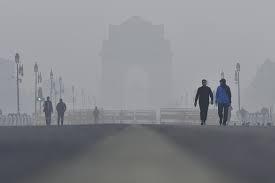Delhi Air Quality Index on Diwali Plunges as Cracker Ban Goes up in Smoke

The air in Delhi and neighbouring areas was thick with toxic smoke as people defied government's ban on firecrackers on Diwali, despite a dramatic spike in emissions from farm fires.
The city's air quality index, which stood at 382 at 4 p.m., continued to rise and reached into the severe zone at 8 p.m. as low temperatures and wind speed allowed pollutants to accumulate.
The nearby cities of Faridabad (424), Ghaziabad (442), Gurgaon (423) and Noida (431) also experienced severe air quality, with cracker bursting peaking after 9 p.m.
People in many parts of the city and its surroundings complained of itchy throats and watery eyes as a layer of haze hung over the region for the first time this season. Residents of Lajpat Nagar in South Delhi, Burari in North Delhi, Paschim Vihar in West Delhi, and Shahdara in East Delhi reported firecrackers popping as early as 7 p.m., despite the national capital's blanket ban in effect until January 1, 2022.
The Haryana government has also banned the sale or use of any types of firecrackers in 14 of the state's districts in the National Capital Region, while limitations have been placed in other areas.
According to experts, the air quality deteriorated due to unfavourable meteorological circumstances (calm winds, low temperatures, and low mixing height) and a toxic cocktail of emissions from firecrackers, stubble burning, and other sources.
According to the Central Pollution Control Board (CPCB), the 24-hour average PM2.5 concentration in Delhi-NCR increased from 243 micrograms per cubic metre at 6 p.m. to 263 micrograms per cubic metre at 9 p.m., exceeding the permissible limit of 60 micrograms per cubic metre. On Thursday, the capital's 24-hour average air quality index (AQI) was 382, up from 314 on Wednesday. On Tuesday, it was 303, and on Monday, it was 281.
An AQI of zero to 50 is regarded 'good,' 51 to 100'satisfactory,' 101 to 200'moderate,' 201 to 300 'poor,' 301 to 400'very poor,' and 401 to 500'severe.'
According to SAFAR model estimates, the proportion of stubble burning may grow to 35% on Friday and 40% on Saturday when the wind direction changes to northwesterly. Smoke from agricultural fires in Punjab and Haryana is carried to the national capital by northwesterly winds.
Relief is predicted only on the evening of November 7, although AQI will remain in the'very bad' level, according to the air quality prediction organisation.
Last year, on November 5, the amount of stubble burning in Delhi's pollution reached at 42%. On November 1, 2019, agricultural residue burning accounted for 44% of Delhi's PM2.5 pollution.
The contribution of stubble burning to Delhi's PM2.5 concentration on Diwali day last year was 32%, compared to 19% in 2019. On October 27, the Delhi government began the 'Patakhe Nahi Diye Jalao' campaign to raise awareness against cracker bursting. Anyone discovered burning crackers can be prosecuted under relevant IPC provisions and the Explosives Act under the campaign.
According to the authorities, approximately 13,000 kg of illicit firecrackers have been recovered, and 33 persons have been detained as part of the anti-cracker effort.





